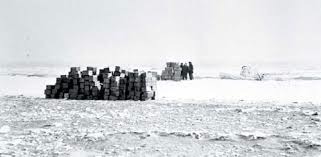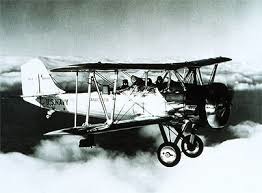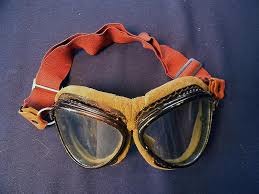MY FATHER ... OUT OF POVERTY
A Success Story Worth Telling
Disaster was in the air when at the age of twenty my father, a farmer, married my nineteen-year-old mother in February 1928. The Great Depression was about to decimate America beginning in October 1929, exactly one year (to the month) after I was born.
“In the beginning”...their beginning (and mine) the promises of the good life were only wishful thinking. I can still remember my mother saying (often), when I was 5 or 6 years of age, “When our ship comes in...” (translation: when our life gets better...). I don’t know if that expression is still used today. I suppose living near the ocean was the reason for it. Living near the ocean did, for some time, account for our family’s modest income.
Prohibition, between 1929 and 1932 or 3, provided the conditions for nighttime truck driving jobs for my father. Here is where living near the Atlantic Ocean combined to join my father’s truck driving skills with the needs of bootleggers who were landing cases of alcohol on to secluded, New Jersey beaches from small boats.

Rum Runners ocean delivery. Pickup and land delivery by my dad.
He was breaking the law. So were the thousands of law-abiding, good citizens when they bought the bottles of alcohol that my father and many others were delivering (not to mention all those countless good people who drank and partied at the many speakeasies that flourished everywhere).
In 1933 it all became legal again and my father was out of a job. By this time he was the father of two sons. Time to try again too earn an honest living. That was no easy goal considering it was depression-time and jobs were scarce, particularly for a 26 year-old man who never finished high school.
Survival Time
You name it, he did it. He was a truck driver (previously
mentioned), shoe salesman, a driver of a bakery truck, a wholesale children’s clothing salesman and a salesman in a department store. These low-paying jobs were separated by varying periods of unemployment. I know I missed a few other jobs but I was no more than six years old during this time.
__________
Becoming An Airplane Pilot
I remember Dad taking me flying in 1933 or 4.

How did he do it? Here is all that I know and remember. I was about six years old at the time (events seemed to happen when I was six years old). There was the flying club he joined or formed. Somehow, somewhere he took flying lessons. I remember that on one occasion he took me flying in a twin winged, opened cockpit plane. I doubt if my mother knew.
Dad’s flying goggles had a crack in one lens.

Then there were his flying goggles. He kept them in the top drawer of an old side table in the living room. I knew where they were and tried them on when my parents weren’t around. They had a cracked lens in one of the eyepieces (I didn’t do it.).
__________
Making The Most Of A “Lucky Break”
“What is photoengraving?” What would a small-town guy know or even hear of such a thing as photoengraving? No matter. A relative did. This relative, an uncle of my father, who was quite fond of him, knew of a job opening at a photoengraving company. There were, however, four problems. First, the job was in, expensive New York City. Our family lived in the small, low cost town of Freehold, New Jersey. Second, the job paid next-to-nothing. Third, the job was menial, one notch above janitor and had little to do with photoengraving but—it was a job! Fourth, was where to live and how to afford rent. (Some lucky break!)
What is that expression? Oh yes, beggars can’t be choosy. My father wasn’t a beggar but he was out of work (with no skills) with a family to support and being helped by his disapproving father-in-law, my grandfather. Pride and the desperate need to care for his family overcame the four problems.
Where to live in New York City was resolved when my father’s, unloving father, Max, reluctantly agreed, at the urging of my father’s mother, to let our family (now with three children) move in to their small Bronx apartment. That’s another story.
Creating the “Lucky Break”
The menial job at the photoengraving company gave my father a chance to get a general idea of what photoengraving was all about. It was enough for a smart, ambitious young man to convince management that he could be a salesman—a good salesman.
I suppose he did well enough to enable us to move out of my grandparent’s apartment into a small apartment of our own in a bad neighborhood known as Fort Apache. I was seven years old. Life was a struggle. How did I know then? We couldn’t afford a radio so I listened to the LONE RANGER on my grandmother’s radio, when I could. And then— there was the box of chocolate donuts. My mother had sent me down to the local grocery store to buy something I no longer remember. While in the grocery store with a dollar (big money then) in my hand I saw a box of chocolate donuts. 25 cents! I had change from the purchase I had made for my mother; more than enough to buy the chocolate donuts. So...I did. My mother made me return them. That memory has stayed with me for 80 years, a symbol of our near-poverty.
Enough about me! My dad was succeeding as a salesman in the photoengraving business, earning a little more money (not yet enough for a box of chocolate donuts as far as my mother was concerned).
Electrotypes?
Dad heard about the sales job opening from another salesman. It was at a company that manufactured electrotypes. Electrotypes? For you, the uninitiated, electrotypes were duplicate printing plates and photoengravings were original, engraved printing plates. That’s all you have to know. They barely exist today if at all. They existed in the 1920s through the ‘60s or 70s.
The transition from photoengraving to electrotyping was an easy step for a smart, ambitious, young guy like my dad. He got the sales job, with an increase in pay, at the F. A. Ringler Co., an electrotype manufacturer. He did extremely well, so well that in less than two years time we could afford to move back to Freehold. My father became a commuter to New York City.
Buying In
Freehold, New Jersey! Back home! We left in near poverty and returned with an almost comfortable income, all within two (depression filled) years. Not bad for a farm boy without a high school diploma. My mother’s ship had not yet come in but was now visible on the horizon.
80% of the F. A. Ringler Co. was for sale by several members of the deceased, founder’s family. The best offer came from a nephew who worked at the company. His problem was that he was unable to come up with the total purchase price for the entire 80% but could manage 40% of the company and another 40% with help. He approached the company’s accountant and my father for the 40% balance of the purchase price making them partners. Wonderful! What an opportunity! There was a problem for my father. He didn’t have the money needed for his share.
That same uncle came to the rescue. He lent my father the money and the sale of 80% of the company was completed with the nephew owning 40% and my father and the accountant each owning 20%. The estate retained 20%.
With imagination and hard work my father and our family began to feel the early benefits of prosperity.
Building Our House
We moved into our newly built house in July 1940. My mother’s ship had come in. Miraculously, with my mother’s support, my father made it happen.
P.S.
My Father’s Secrets
Many years later I asked my father, “Dad, how did you do it?”
He smiled and replied, “Do what?”
“Well, for one thing, how could you afford flying when you were in and out of work?”
My father smiled again and answered, “That’s a secret.”
“Tell me”, I pressed him, “how did you manage to go from a poor, uneducated farmer to where we are today during the depression?”
He laughed and replied, “That’s another secret. I’ll share that one with you.” And—he did.
I’ll Share That Secret With You ... If You Are Interested
Let Me Know
Bob Flicker